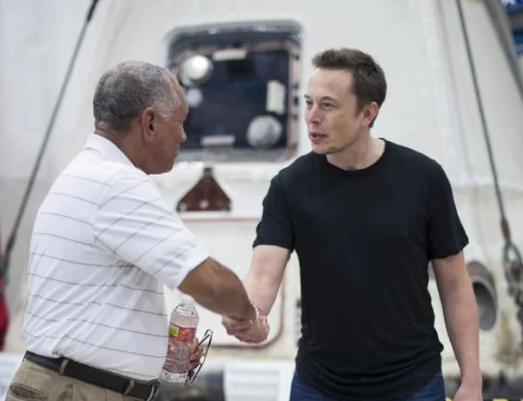aNewDomain –SpaceX CEO Elon Musk has published a paper detailing the company’s four-stage plan to colonize Mars. It describes how the company might create power and breathable air on the Red Planet. It also details some of the tech the firm is planning for a fleet of Earth-Mars reusable transport vehicles.
 The fleet’s first and largest spaceship, like the one in the cult classic novel “The Hitchhiker’s Guide to the Galaxy,” will be called Heart of Gold, he said.
The fleet’s first and largest spaceship, like the one in the cult classic novel “The Hitchhiker’s Guide to the Galaxy,” will be called Heart of Gold, he said.
The paper, as published in the June 14, 2017 issue of the journal New Space, details SpaceX’s so-called Interplanetary Transport System (ITS), a reusable rocket-cum-spaceship system he hopes to debut in about 10 years.
There’s a decent amount of detail regarding the rocket tech, propellant plans and an all carbon fiber fuel tank that Musk says will power it all. The latter recently passed its first big pressure test, he said.
 Even if you doubt some of the lofty premises inside, the paper is a terrific read for anyone interested in the relatively near future of interplanetary space travel.
Even if you doubt some of the lofty premises inside, the paper is a terrific read for anyone interested in the relatively near future of interplanetary space travel.
The paper is companion text for the 60-slide Mars colonization and transport presentation Musk delivered at the International Astronautical Congress in Mexico last September, SpaceX reps said this month.
Find that presentation and the full text of the Musk’s recently released paper at the end of this post.
For sure, this material is worth a deep dive for anyone intrigued with the future of spacefaring. Even if you doubt some of Musk’s lofty premises, it’s great fodder and, certainly, well thought out.
Here are some of the high points.
The most powerful rocket in history?
The Raptor engine technology SpaceX is developing now is key to the Heart of Gold design, he said. Raptor is three times more powerful than the Merlin technology that currently powers SpaceX’s Falcon9, and the ship will employ 42 Raptors at once to make the booster “the most powerful rocket in history,” Musk said.
By most powerful, Musk is referring the booster’s ability to launch some 330 tons of mass up to low Earth orbit.
That is more than double what NASA’s legendary Saturn V moon rocket could hoist.
Maneuvering thrusters, pinpoint landings
The key feature of SpaceX’s ITS, Musk writes, will be their ability to achieve pinpoint landings. Falcon9 landing precision is ever-improving, he says, adding that the addition of maneuvering thruster technology will radically improve accuracy. “It will “actually put the booster right back on the launch stand,” Musk says.
The ITS boosters will launch countless spaceships and fuel tankers over their lifetimes, he adds, saying they will be designed to fly more than 1,000 times each.
As for the spaceships, the idea is that they stay in orbit until Earth and Mars are at optimal alignment, which happens once ever 26 months. At that point, they’ll take off as a fleet.
And how big would such a fleet be? Hang on to your hat. Musk envisions at least 1,000 ITS spaceships, each capable of carrying 100 men and women.
be? Hang on to your hat. Musk envisions at least 1,000 ITS spaceships, each capable of carrying 100 men and women.
That makes sense. In previous statements, Musk has said the goal is to get one million people to Mars in the next 50 to 100 years.
The ships would also fly back from Mars, using their nine Raptor engines and methane-based propellant that was manufactured on the Red Planet.
Each ITS ship would probably be able to make 12 to 15 deep-space journeys during its operational life, Musk wrote.
Each fuel tanker could likely fly to Earth orbit 100 or so times, he added.
 “A huge amount of risk”
“A huge amount of risk”
Reusability ships are key to affordable Mars travel, Musk says, and they are at the center of his argument that $200K per person travel to Mars may be possible in our lifetimes.
And the timeframe? The first launch could take place in about 10 years, writes s Musk, though he is decidedly fuzzy on the timeframe — and careful in the paper to point out that success is anything but a given.
“There is a huge amount of risk,” says Musk. Mars travel ” is going to cost a lot .. [and] there is a good chance we will not succeed, but we are going to do our best and try to make as much progress as possible.”
We are going to try to send something to Mars on every Mars rendezvous from this point on. We plan to send Dragon 2, which is a propulsive lander, to Mars in a couple of years, and then probably do another Dragon mission in 2020,” Musk writes. “We want to establish a steady cadence, so that there is always a flight leaving, just like there is a train leaving the station. With every Mars rendezvous, we will be sending at least [one] Dragon to Mars and, ultimately, the big spaceship.”
 Dragon 2, it’s worth noting, will be a propulsive lander. That, of course, means Mars is just the beginning, and Musk underlines that, too.
Dragon 2, it’s worth noting, will be a propulsive lander. That, of course, means Mars is just the beginning, and Musk underlines that, too. Elon Musk: Making Humans a Multi-Planetary Species by Gina Smith on Scribd
Here’s Musk’s slides on the Mars reusable transport system and colonization plans.
Elon Musk: Full Mars Presentation with Spaceship Architecture, Details by Gina Smith on Scribd
Cover image: Rendering of a Mars colony, SpaceX file image, All Rights Reserved. All inside images via New Space; All Rights Reserved.














